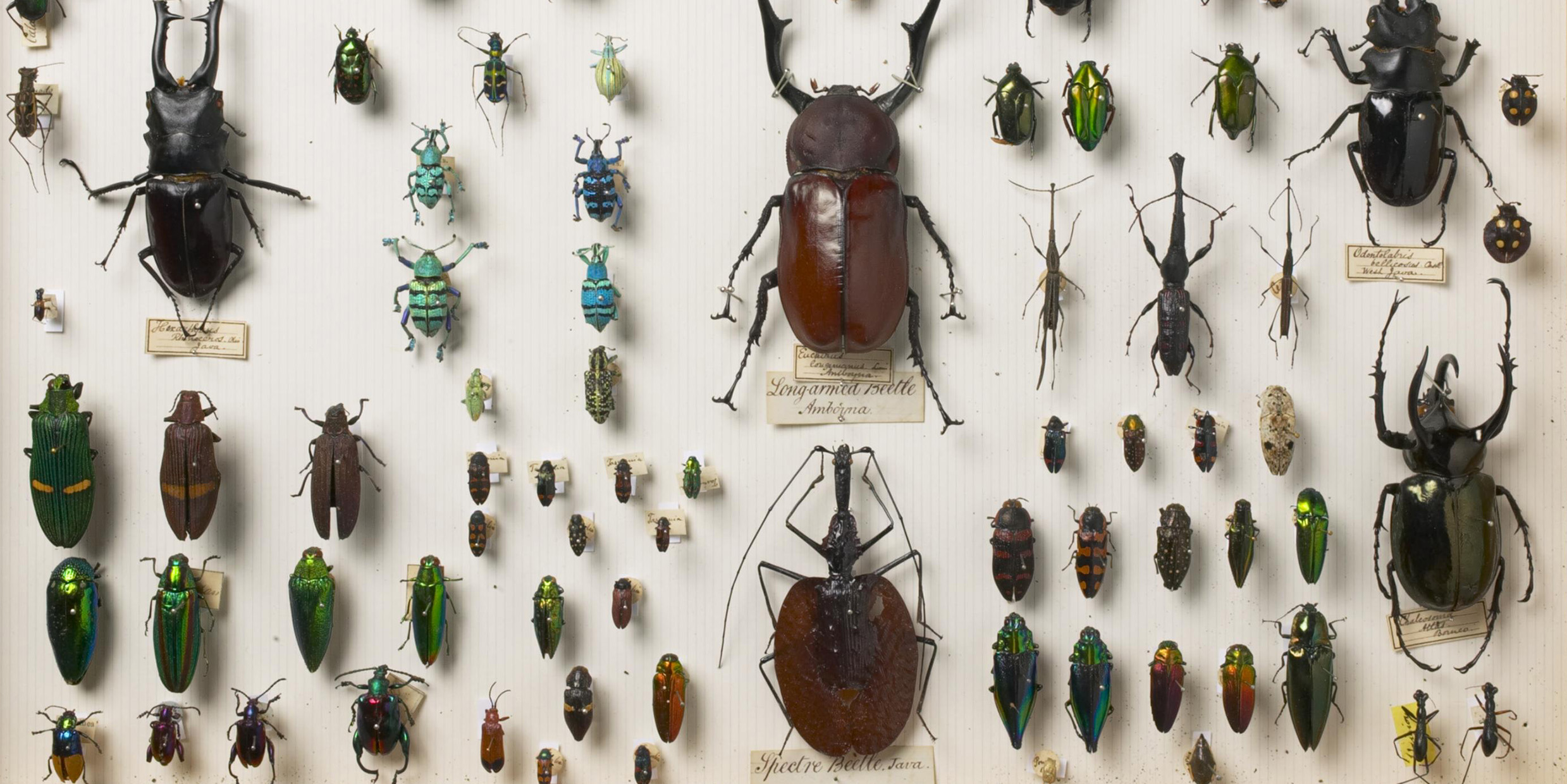Originally published 26 November 1990
I’ve seen the British Crown Jewels on display at the Tower of London. I once visited an exhibit of gem-encrusted Easter eggs created for the Russian Czars by Peter Carl Fabergé, the finest jeweler of Europe. I’ve browsed wide-eyed among the treasures at Tiffany’s.
All of these artful baubles pale before the natural beauty of beetles.
Beetlemania! That’s the name of a [1990] exhibit of beetles offered by Harvard’s Museum of Comparative Zoology. Thousands of specimens from the Museum’s vast beetle collection (three-and-a-half million specimens representing 100,000 species collected worldwide) are attractively displayed and interpreted.
And they are gorgeous. Gemstone gorgeous. Gaudy, iridescent jewel-bugs, shimmering in colors of turquoise, sapphire, opal, and ruby.
One group of thumb-sized scarab beetles appears to have been fashioned from precious metals: gold, silver, and platinum. The backs of certain leaf beetles seem to be studded with hundreds of tiny diamonds.
Every group of beetles on display offers something in the way of bijou beauty. Pearls, rhinestones, and Indian beads. Polished ebony and ivory. Mother-of-pearl brooches, lapis lazuli stick-pins, and emerald pendants big enough and rich enough to dangle grandly in Liz Taylor’s decolletage.
What makes the Coleoptera (beetles) so endlessly fascinating is their apparently superfluous ornamentation. They are far more flamboyantly decorated than any theory of evolution would seem to require. What possible advantage in the struggle for survival is bestowed on the Calodema beetle by its astonishing box-of-Crayolas coloration? What is the reason for the fabulous polka dots and splotches on the backs of ladybugs? Why do leaf beetles sport such a goofy profusion of spikes, fuzz, frills, pits, and knobs, all in decorator colors?
Created on the Seventh Day
Those folks who prefer to explain the world as the piecework of a divine craftsman could offer no better proof of their faith than beetles. It is difficult to imagine any combination of natural laws creating the beetles on display at Harvard. Beetles are pure whimsy. Beetles are art for art’s sake. Beetles are the work of the Seventh Day, when the Creator was just foolin’ around havin’ fun.
Of course, biologists are unwilling to concede that even the most wildly ornamented beetles don’t somehow fit into the evolutionary scheme. Classic examples of Darwinian adaptation are plentiful in the Harvard exhibit, including beetles from Arizona that have evolved colors to match the rocks they live on — red for red sandstone, black for black volcanic rock — the better to escape predators.
But what of those thumb-sized scarabs with backs of sterling silver or 24-carat gold? Biologists lamely suggest that in tropical rain forests these shiny metallic colors act as mirrors, reflecting the vegetation of the forest, thereby functioning as a kind of all-purpose camouflage. Smaller metallic beetles, they say, are shiny to mimic drops of water on a wet surface.
These Darwinian explanations are, I suppose, reasonable enough, but to my inexpert mind the spectacular variability of beetles suggests that nature is infected by beetlemania — a sheer lunatic exuberance for diversity, a manic propensity to try any damn thing that looks good or works.
Everything, in fact, but the kitchen sink! Click beetles, stink bugs, fireflies, burying beetles, banjo beetles, stag beetles, whirligigs, and tumble bugs. They are all here, in their mind-boggling profusion, glittering like gems.
Beetles as tiny as the point of a pin: They don’t even need to beat their wings to fly; they simply spread their feathery wings and float away like motes of dust in the air.
Beetles as big as baseballs: The Goliath beetle of tropical Africa, when airborne, can shatter the windshield of a Jeep.
Beetles that eat dirt: Pill beetles found in the Israeli desert gobble up so much soil they recycle the entire desert every 15 years.
Beetles that scuba dive: Whirligig beetles trap a bubble of air under their belly and use it as an aqualung to stay under water for an extended period of time.
Beetles that roll little balls of dung: Ancient Egyptians worshiped the dung-rolling scarab beetle, imagining it to be a suitable image of the god that rolls the sun across the sky each day.
Beetles, beetles everywhere
And what’s on display at the museum is only a tiny fraction of what lies hidden in dark drawers in the nether regions of the museum — a Fort Knox full of coleopteran riches. Beetles are the most diverse creatures on Earth. There are probably between 5 and 50 million species of living organisms and beetles account for a quarter of them.
When asked what he had learned about the Creator by studying the creation, the renowned evolutionary biologist J. B. S. Haldane is said to have replied, “He must have an inordinate fondness for beetles.”
If beetles are indeed the work — or play — of the Seventh Day, then the Creator was busy from dawn to dusk.



